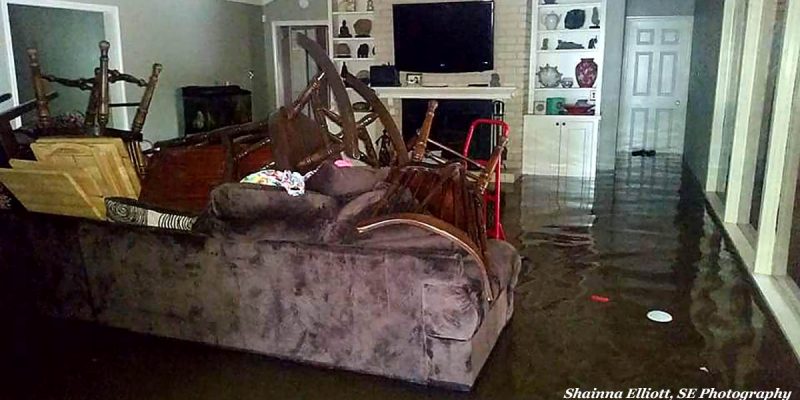Having spent a few years Keeping it Weird in the capital city, half my heart will always be in Texas. So today, this Louisiana woman wants to share flood reality and recovery news our neighbors could use–now and for the foreseeable future.
During the stint with the Texas Windstorm Insurance Association (TWIA) that brought me to the Lone Star State, I once upon a time devoted many hours and much energy to informing and educating Texans from the Rio Grande Valley to Corpus Christi–and up into Harris County where Houston sits (currently underwater) with regard to hurricane preparedness and recovery.
I moved home to Louisiana in 2016 to be here for family ravaged by the Great Flood. I had actually been packing my bags for a visit home to see my sister’s new house in Greenwell Springs on Friday morning, August 12, when my phone started blowing up with weather warnings. I postponed my trip, and by the time I made it to see her place, it was no longer a dream home but something out of a nightmare.
Advertisement
Seems I left Texas just ahead of the storm–the indomitable Hurricane Harvey–that would mercilessly batter Houston and beleaguer the coastal counties. So to our neighbors from the beaches I vacation on to the city of Houston where I first fell in love with baseball, vintage shopping, and grilled cheese with tomatoes and–is that Thousand Island?–(I’m looking at you, House of Pies on Kirby). . . We feel your pain, and we won’t let you go it alone. Here’s what experience has taught us (thanks to Hayride readers and friends of publisher Scott McKay for input).
What to do–when there’s still time:
- Get a timestamp app and take photos of every room in your house (including closets and pantries)
- Take photos of all your furniture and appliances, including a photo of the label with the model and serial numbers (this includes computers, vacuums, and small kitchen appliances–basically anything with a plug)
- Keep all important documents, insurance information, receipts for appliances, and important photos with you
- Put valuable items in your attic or high in your closets
- Use cinder blocks to raise furniture
- Clean out the refrigerator and freezer (after photographing contents for insurance); save yourself from the potential mess/stench (and know that a closed fridge is likely to become a floating fridge)
- Get cash
When the waters rise to meet you:
- Cut off power to the house ASAP
- Contact your insurance company
- Contact FEMA
- Order dehumidifiers, box fans, face masks, and Microban/sprayer bottles online ASAP; these things will be very hard to find once clean up starts
- Use the timestamp app on your phone to document the damage for your insurance company. Before entering your home, take photos of the water line around the outside of your house. Take photos of the water line in every room, including the garage, pantries, and closets.
- Keep a sample of flooring (1 square foot) from each room in the house so insurance gives you proper compensation for those materials
- Make a list of all appliances, furniture, and clothing that was damaged
- Look up videos on YouTube on how to quickly remove sheet rock. It will save you demo time and make things easier when your contractor reinstalls your walls
- Get license and insurance info from every contractor you talk to! Do not hire someone who is not licensed and insured. A good contractor will have this with him and will not hesitate to give proof of these things
When it’s safe to survey the damage:
- Ensure your main breaker is OFF
- Remove carpet and drywall to prevent mold (Drywall comes in 4 ft sheets; finding the wall seam makes removing it a lot easier
- Get a face mask, gloves, a hammer, a crow bar, and a drywall saw. . .really helpful for gutting
- Keep your water damaged wooden furniture; see if it’s salvageable once it dries out
- Get your studs treated for mold once your moisture levels are low enough; you could do this yourself with the proper mold control products
And for the flood coverage crowd:
- Get familiar with your flood insurance policy and what it does/does not cover
- Take those time stamped pics of each room; document all damage in and around the house
- Compare quotes from reputable contractors; know the best will book up quickly
- Get receipts for all work done on your home
- If the amount your adjuster (finally) comes back with doesn’t seem right and isn’t enough to rebuild with, appeal it!
And please, our brothers and sisters to the west, take what comfort you can in knowing we have your back–and in the words of Jim DeFede, “Neighbor to neighbor. It is a mentality that has been fostered over centuries, since the earliest settlers realized the only way to survive in this desolate but beautiful outpost was to work together.”
From The Day the Water Came to Texas forward–we’re here for you.
Advertisement
Advertisement

